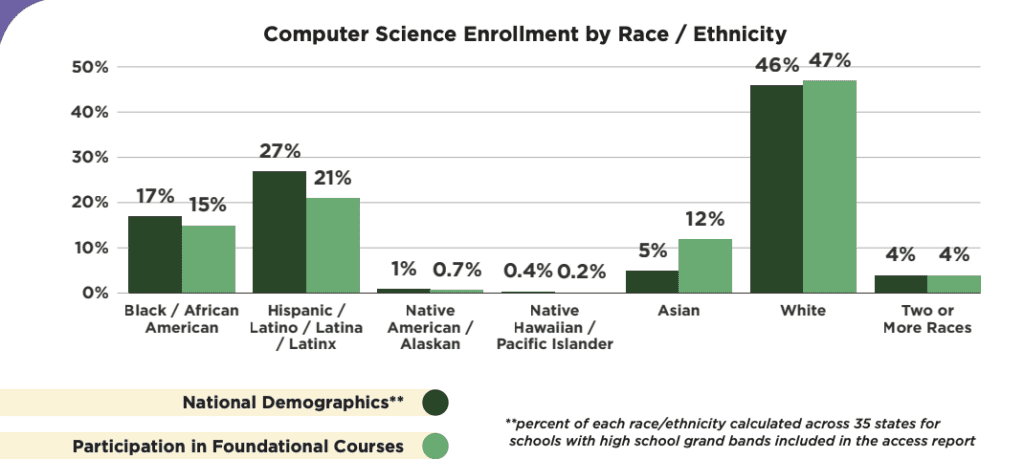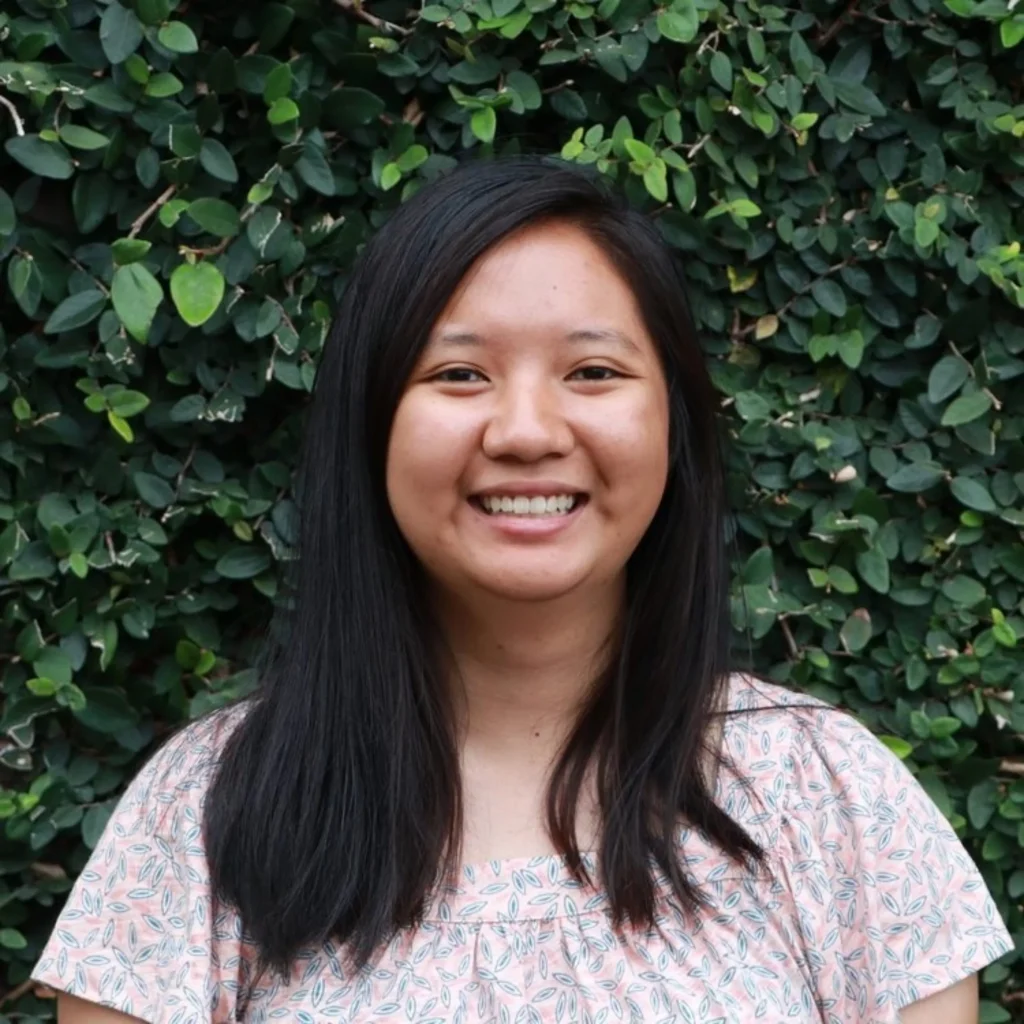By: Michaela De Guzman

Computer Science Education: Retrieved from https://advocacy.code.org/stateofcs
According to Code.org’s State of CS Report, 12% of Asians participated in foundational Computer Science courses – this is more than double the national demographic of 5%. Does that mean we no longer have to worry about Asian American representation in tech?
Like with all data, this only tells part of the story.
In 2020, the organization Stop AAPI Hate was formed to address the rise of anti-Asian sentiments during the start of the Covid-19 global pandemic. Quickly, the narrative of the Model Minority Myth, a narrative that paints Asians as successful because of their hard work and good behavior, is questioned. If we were truly equal, why are we still seen as outsiders in our community?
As a Filipina-American woman, it has been hard to describe my experiences until I came across Cathy Hong’s Minor Feelings: “We keep our heads down and work hard, believing that our diligence will reward us with our dignity, but our diligence will only make us disappear.”
There are many narratives on how Asian students are “geniuses” or don’t need extra support, but as a result, a gap forms in what Asian students are being told and what Asian students are actually experiencing. Often, this results in Asian students minimizing their own experience because it does not match the dominant narrative. While data might tell a story of the Asian American population thriving in tech, we have to unpack and understand the unique ways Asian American students face discrimination.
In this article, I would like to address three main points when thinking about your Asian American students. This article is by no means comprehensive and is only meant to be a starting point for exploring Asian American identity and challenges they face. At the heart of it, we must listen to the unique ways their Asian American identity is intertwined with their experiences, as no student connects with their identity the same way.
1. Unpacking “Asian American”
The term “Asian American” is rooted in the collective fight for equity in the 1960s and was coined by Yuji Ichioka and Emma Gee. While the community supports and uplifts each other in shared experiences, it’s also important to recognize that this term encompasses more than 20 countries each with its unique history, culture, and language.
While many aspects of East Asian culture have found their way into American popular culture, I ask you to consider how familiar you are with its other countries. Looking at this Asian and Pacific Islanders Identities and Diversity list of countries, which countries are you familiar with? Which countries do your students identify with?
Furthermore, even with this knowledge, we cannot make assumptions about a student’s experiences. Their ethnicity doesn’t decide where and what culture they grow up with. A family that has been in the USA for several generations will have a different experience growing up than a family who may have just immigrated. Every student has a unique experience and relationship with their identity, and it’s important to start from curiosity rather than assumptions.
2. Considering intersectionality
Remember, “Asian American” is but one part of their identity. Our students are multifaceted individuals with different genders, sexualities, neurodiversities, religions, socioeconomic classes, and so much more.
Intersectionality is a term coined by Kimberlé Crenshaw, and is a way for understanding how overlapping identities relate to discrimination. For example, Asian women have expressed unique barriers, facing stereotypes and discrimination in the tech workplace that Asian men do not experience. We cannot flatten our student’s experiences by deeming one identity “more defining” than the other.
3. Are we truly being inclusive?
Even with all these statistics, we need to ask —Does the dominant culture truly accept Asians bringing their whole selves?
The Bloomberg article, Why Silicon Valley’s Many Asian American Still Feels Like a Minority, details the experiences of four Asian Americans in Silicon Valley who were barred from leadership positions due to Asian stereotypes and assumptions. While data-wise, Computer Science seems to be an inclusive field for Asians, we must ask how much are their voices being valued?
Recommendations
While data can tell the participation in Computer Science, we also must ensure that we are creating an environment that elevates the voices and experiences of the Asian American community. This AAPI month, I challenge you to take the following actions to dispel tired narratives that flatten our student’s experiences:
- Create space for students to share and explore their own identity. Educators should create space for students to voluntarily share information about themselves. Never ask a student where they are originally from as a way of understanding their background. Being singled out because of their identity as an Asian-American can be damaging as it reinforces feelings of being an outsider. Instead, focus on creating an environment where students feel safe, comfortable, and not judged for sharing their own experiences through Culturally Sustaining Pedagogy. Remember, the student is the expert on their own lived experiences.
- Seek out AAPI-centered media. Don’t rely only on your students to do the complex emotional work of explaining the nuances of their feelings. There are multitudes of AAPI perspectives that would be helpful to explore additional context for a deeper understanding. The experiences your students have may not be reflected one to one in the media, but your exploration gives you a better frame of reference to connect with your students.
- Reflect on your own biases, and start the process of unlearning them. Even as a Filipina-American woman, I grew up hearing different stereotypes and assumptions about different Asian communities. The things we hear from others and in the media can unconsciously show up in our everyday actions even if we don’t agree with them. We must start being aware of them and learn how it can affect our students. This resource, Learn about bias & discrimination against the Asian and Pacific Islander community, is a good starting point for learning more.
To achieve true Computer Science equity, we must actively work to unlearn the damaging narratives that unfairly define our students, and ensure our Asian American students are seen for the whole person with intersecting identities and the unique experiences and ideas that they bring.
About the Author

Michaela De Guzman is currently entering her third year as a Curriculum Developer for Girls Who Code. She began her career teaching coding to K-6 in Title I schools for two years where she fell in love with Computer Science Education. Ever since, she has remained committed to students feeling empowered through problem solving and expressing themselves through code. In her time at Girls Who Code, she has co-developed Cybersecurity and Data Science courses focused on social justice, along with activities around creative computing and machine learning. She is dedicated to elevating student voices in the tech space, especially those in historically underrepresented groups such as BIPOC and women. Her dream is for every student to feel empowered to shape our technologies to create more inclusive and equitable designs and therefore a more inclusive, equitable world.

